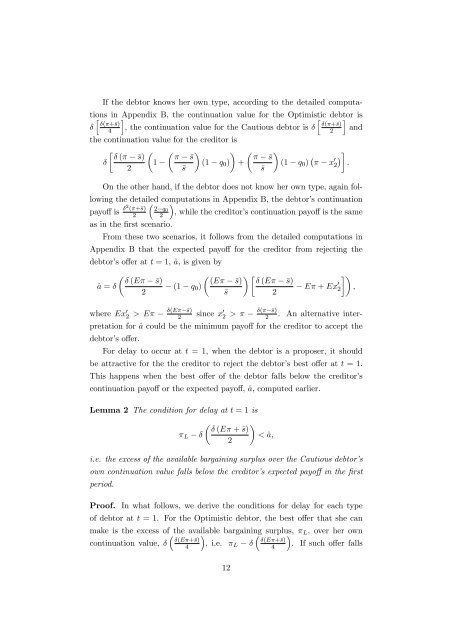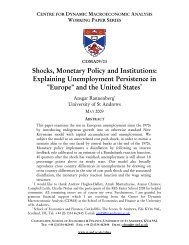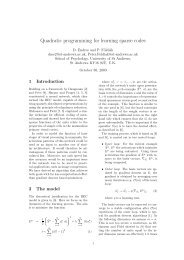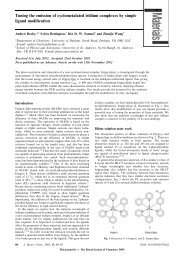Delay and Haircuts in Sovereign Debt - University of St Andrews
Delay and Haircuts in Sovereign Debt - University of St Andrews
Delay and Haircuts in Sovereign Debt - University of St Andrews
Create successful ePaper yourself
Turn your PDF publications into a flip-book with our unique Google optimized e-Paper software.
If the debtor knows her own type, accord<strong>in</strong>g to the detailed computations<br />
<strong>in</strong> iAppendix B, the cont<strong>in</strong>uation value for the Optimistic debtor i is<br />
, the cont<strong>in</strong>uation value for the Cautious debtor is <strong>and</strong><br />
h<br />
(+s)<br />
4<br />
the cont<strong>in</strong>uation value for the creditor is<br />
<br />
( s) s<br />
<br />
1<br />
(1 q 0 )<br />
2<br />
s<br />
<br />
+<br />
s<br />
s<br />
h<br />
(+s)<br />
2<br />
<br />
(1 q 0 ) x 0 2 :<br />
On the other h<strong>and</strong>, if the debtor does not know her own type, aga<strong>in</strong> follow<strong>in</strong>g<br />
the detailed computations <strong>in</strong> Appendix B, the debtor’s cont<strong>in</strong>uation<br />
payo¤ is 2 (+s) 2 q0<br />
2 2<br />
, while the creditor’s cont<strong>in</strong>uation payo¤ is the same<br />
as <strong>in</strong> the …rst scenario.<br />
From these two scenarios, it follows from the detailed computations <strong>in</strong><br />
Appendix B that the expected payo¤ for the creditor from reject<strong>in</strong>g the<br />
debtor’s o¤er at t = 1, ^a, is given by<br />
(E<br />
^a = <br />
2<br />
s)<br />
(E<br />
(1 q 0 )<br />
s<br />
s) (E<br />
2<br />
s)<br />
<br />
E + Ex 0 2 ;<br />
where Ex 0 2 > E (E s)<br />
2<br />
s<strong>in</strong>ce x 0 2 > ( s)<br />
2<br />
. An alternative <strong>in</strong>terpretation<br />
for ^a could be the m<strong>in</strong>imum payo¤ for the creditor to accept the<br />
debtor’s o¤er.<br />
For delay to occur at t = 1, when the debtor is a proposer, it should<br />
be attractive for the the creditor to reject the debtor’s best o¤er at t = 1.<br />
This happens when the best o¤er <strong>of</strong> the debtor falls below the creditor’s<br />
cont<strong>in</strong>uation payo¤ or the expected payo¤, ^a, computed earlier.<br />
Lemma 2 The condition for delay at t = 1 is<br />
L<br />
<br />
(E + s)<br />
<br />
< ^a;<br />
2<br />
i.e. the excess <strong>of</strong> the available barga<strong>in</strong><strong>in</strong>g surplus over the Cautious debtor’s<br />
own cont<strong>in</strong>uation value falls below the creditor’s expected payo¤ <strong>in</strong> the …rst<br />
period.<br />
Pro<strong>of</strong>. In what follows, we derive the conditions for delay for each type<br />
<strong>of</strong> debtor at t = 1. For the Optimistic debtor, the best o¤er that she can<br />
make is the excess <strong>of</strong> the available barga<strong>in</strong><strong>in</strong>g surplus, L , over her own<br />
cont<strong>in</strong>uation value, , i.e. L . If such o¤er falls<br />
<br />
(E+s)<br />
4<br />
12<br />
<br />
(E+s)<br />
4
















